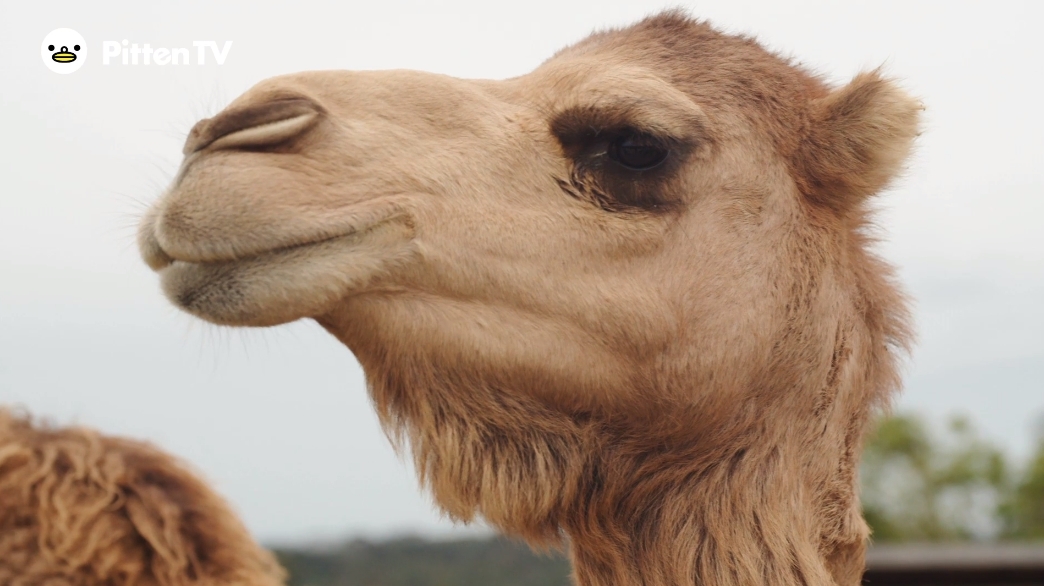[ 2024.06.21 ] June 22nd is World Camel Day.
【Pitten ZOO】6月22日は、世界ラクダの日です。

日本人にとってラクダが家畜であるという認識はあまりないかもしれませんが、世界的には重要な家畜として認識されています。そんな家畜としてのラクダにも焦点を当てる「世界ラクダの日」が毎年6月22日に開催されています。この日は、ラクダの歴史や重要性を人々に伝え、砂漠の動物であるラクダの未来を考える機会となっています。
創始者のアブドゥル・ラジク・カカール博士はラクダ乳製品の専門家で、気候変動のシナリオにおいて食糧安全保障の担い手としてのラクダの重要性を人々に認識してもらうため、2009年に世界ラクダの日(WCD)というアイデアを構想し、提唱しました。
ラクダには、ヒトコブラクダと2種のフタコブラクダが現存しています。コブには脂肪が入っており、エネルギーを蓄えるだけでなく、断熱材としても働き、汗をほとんどかかないラクダの体温の上昇を抑える役割もあります。ラクダは、砂漠などの乾燥地帯に最も適応した家畜です。
もともとは、1年でもっとも最も日が長く、暑さの象徴でもあることから、暑さや乾燥に強いラクダのイメージに合っているということで、夏至の日(6月21日)を選ぼうとしたのですが、すでに「世界父の日」が指定されていたため、翌日の6月22日を選んだということです。
世界ラクダの日は、ラクダの文化的重要性だけでなく、気候変動や食料安全保障の課題に直面する現代社会において、ラクダの持つ適応力や持続可能性の象徴としての価値を再認識する機会となっています。
Pitten ZOO:ラクダの動画をみる
2024年は国連によって、国際ラクダ科年として定められています。2017年に国連総会で決議され、2024年を「ラクダ類の国際年」とすることが決定されました。気候変動や食料安全保障の課題に直面する中、ラクダの適応力は持続可能性の象徴として注目されています。
対象動物:フタコブラクダ、ヒトコブラクダ、ラマ、アルパカ、ビクーニャ、グアナコ
ラクダ科の動物は、砂漠や山岳地帯に住む人々の生活に不可欠であり、極端な気候条件下でも生産性と環境保護に貢献できる動物です。90カ国以上の数百万世帯にとって、ラクダ科動物は必要不可欠な存在とされています。また、これらの動物はラクダ科の動物は多くの地域で伝統的な文化遺産の一部となっており、芸術、工芸、文学などに影響を与えています。
国際ラクダ科年は、ラクダ科動物の多面的な価値を再認識し、その保護と持続可能な利用を促進する重要な機会となります。
Pitten ZOO:ラクダ科を動画でみる
参考)
ARKBIODIV.COM
https://camel4all.info/
国際連合食糧農業機関(FAO)
創始者のアブドゥル・ラジク・カカール博士はラクダ乳製品の専門家で、気候変動のシナリオにおいて食糧安全保障の担い手としてのラクダの重要性を人々に認識してもらうため、2009年に世界ラクダの日(WCD)というアイデアを構想し、提唱しました。
ラクダってどんな動物?
ラクダには、ヒトコブラクダと2種のフタコブラクダが現存しています。コブには脂肪が入っており、エネルギーを蓄えるだけでなく、断熱材としても働き、汗をほとんどかかないラクダの体温の上昇を抑える役割もあります。ラクダは、砂漠などの乾燥地帯に最も適応した家畜です。
なぜ6月22日なのか?
もともとは、1年でもっとも最も日が長く、暑さの象徴でもあることから、暑さや乾燥に強いラクダのイメージに合っているということで、夏至の日(6月21日)を選ぼうとしたのですが、すでに「世界父の日」が指定されていたため、翌日の6月22日を選んだということです。
世界ラクダの日は、ラクダの文化的重要性だけでなく、気候変動や食料安全保障の課題に直面する現代社会において、ラクダの持つ適応力や持続可能性の象徴としての価値を再認識する機会となっています。
Pitten ZOO:ラクダの動画をみる
2024年は、国際ラクダ科年
2024年は国連によって、国際ラクダ科年として定められています。2017年に国連総会で決議され、2024年を「ラクダ類の国際年」とすることが決定されました。気候変動や食料安全保障の課題に直面する中、ラクダの適応力は持続可能性の象徴として注目されています。
対象動物:フタコブラクダ、ヒトコブラクダ、ラマ、アルパカ、ビクーニャ、グアナコ
ラクダ科の動物は、砂漠や山岳地帯に住む人々の生活に不可欠であり、極端な気候条件下でも生産性と環境保護に貢献できる動物です。90カ国以上の数百万世帯にとって、ラクダ科動物は必要不可欠な存在とされています。また、これらの動物はラクダ科の動物は多くの地域で伝統的な文化遺産の一部となっており、芸術、工芸、文学などに影響を与えています。
国際ラクダ科年は、ラクダ科動物の多面的な価値を再認識し、その保護と持続可能な利用を促進する重要な機会となります。
Pitten ZOO:ラクダ科を動画でみる
参考)
ARKBIODIV.COM
https://camel4all.info/
国際連合食糧農業機関(FAO)
Japanese people may not be aware that camels are livestock, but they are recognized as important livestock worldwide. World Camel Day, which focuses on camels as livestock, is held every year on June 22nd. This day is an opportunity to inform people of the history and importance of camels and to think about the future of camels, which are desert animals.
Founder Dr. Abdul Raziq Kakar is an expert on camel dairy products, and he conceived and proposed the idea of World Camel Day (WCD) in 2009 to make people aware of the importance of camels as a source of food security in a climate change scenario.
There are two types of camels: dromedary and two Bactrian camels. The humps contain fat, which not only stores energy but also acts as insulation and helps to prevent the body temperature of camels, who hardly sweat. Camels are the livestock that are best adapted to dry areas such as deserts.
Originally, they wanted to choose the summer solstice (June 21st) because it is the longest day of the year and is also a symbol of heat, which matches the image of camels that are resistant to heat and dryness. However, since "World Father's Day" had already been designated, they chose the following day, June 22nd.
World Camel Day is an opportunity to reaffirm not only the cultural importance of camels, but also their value as a symbol of adaptability and sustainability in modern society facing challenges such as climate change and food security.
Pitten ZOO: Watch camel videos
2024 has been designated as the International Year of Camelidae. In 2017, the United Nations General Assembly decided to designate 2024 as the "International Year of Camels." In the face of climate change and food security challenges, the adaptability of camels has made them a symbol of sustainability.
Featured animals: Bactrian camel, dromedary, llama, alpaca, vicuña, guanaco
Camelidae are essential to the livelihoods of people living in deserts and mountains, and contribute to productivity and environmental protection even under extreme climatic conditions. Camelidae are an essential part of the lives of millions of households in more than 90 countries. They are also part of the traditional cultural heritage of many regions, influencing arts, crafts and literature.
The International Year of Camelidae is an important opportunity to recognize the multifaceted value of camelids and promote their conservation and sustainable use.
Pitten ZOO: Watch a video of the Camelidae family
Reference)
ARKBIODIV.COM
https://camel4all.info/
Food and Agriculture Organization of the United Nations (FAO)
Founder Dr. Abdul Raziq Kakar is an expert on camel dairy products, and he conceived and proposed the idea of World Camel Day (WCD) in 2009 to make people aware of the importance of camels as a source of food security in a climate change scenario.
What kind of animal is a camel?
There are two types of camels: dromedary and two Bactrian camels. The humps contain fat, which not only stores energy but also acts as insulation and helps to prevent the body temperature of camels, who hardly sweat. Camels are the livestock that are best adapted to dry areas such as deserts.
Why June 22nd?
Originally, they wanted to choose the summer solstice (June 21st) because it is the longest day of the year and is also a symbol of heat, which matches the image of camels that are resistant to heat and dryness. However, since "World Father's Day" had already been designated, they chose the following day, June 22nd.
World Camel Day is an opportunity to reaffirm not only the cultural importance of camels, but also their value as a symbol of adaptability and sustainability in modern society facing challenges such as climate change and food security.
Pitten ZOO: Watch camel videos
2024 is the International Year of Camelidae
2024 has been designated as the International Year of Camelidae. In 2017, the United Nations General Assembly decided to designate 2024 as the "International Year of Camels." In the face of climate change and food security challenges, the adaptability of camels has made them a symbol of sustainability.
Featured animals: Bactrian camel, dromedary, llama, alpaca, vicuña, guanaco
Camelidae are essential to the livelihoods of people living in deserts and mountains, and contribute to productivity and environmental protection even under extreme climatic conditions. Camelidae are an essential part of the lives of millions of households in more than 90 countries. They are also part of the traditional cultural heritage of many regions, influencing arts, crafts and literature.
The International Year of Camelidae is an important opportunity to recognize the multifaceted value of camelids and promote their conservation and sustainable use.
Pitten ZOO: Watch a video of the Camelidae family
Reference)
ARKBIODIV.COM
https://camel4all.info/
Food and Agriculture Organization of the United Nations (FAO)